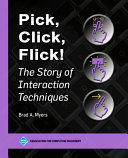Product desciption
Pick Click Flick The Story Of Interaction Techniques Brad A Myers by Brad A Myers 9798400709470, 8400709470 instant download after payment.
This book provides a comprehensive study of the many ways to interact with computers and computerized devices. The opening chapter defines and motivates these interaction techniques and why they are important. Part I then provides a comprehensive but brief history of desktop and mobile interaction techniques and the important historical systems and interaction styles that hosted them. Part II looks in detail at the various kinds of interaction techniques, with each chapter focusing on a different one. The chapters explain the history and design variations and considerations, as well as the constraints that drive the designs: pointing devices, scrolling, percent-done progress indicators, menus, text entry, forms and dialog boxes, graphical editing, window managers, three-dimensional interactions, ubiquitous computing, gesture recognition, undo, help, assistive techniques for people with disabilities, and artificial intelligence techniques. Part III focuses on using, designing, and implementing interaction techniques, including more “meta” issues about interaction techniques in general. Much of this part is focused on programmers who will need to write code to use interaction techniques or to make new ones work. Interaction designers and graphic designers, even if they are not programmers, might need to know some of the material in this part to help evaluate existing interaction techniques or design and evaluate new ones. Finally, Part IV summarizes interviews with the original inventors or designers of some interaction techniques, based on guest lectures they gave to my class. As these are based on those lectures, I was only able to include people who agreed to talk and also agreed to have their lecture recorded (which unfortunately eliminated May-Li Khoe’s talk about the Apple Force Touch).


